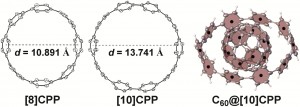Cyclic paraphenylenes (CPPs), first made in 2008, have potential roles in carbon nanotube synthesis as well as interesting optoelectronic properties and nano-sized cavities. Despite their potential, scientists haven’t explored them much for materials and nano applications because they’ve been really difficult to make at a reasonable scale – 10-15mg is typical – and they are expensive.
Now, scientists in the US have come up with a procedure to make 20g of a common intermediate within a week, which can be used to make gram quantities of cyclic paraphenylenes. They developed a macrocyclisation step that uses a much cheaper palladium source than before (ligand-free), reducing the cost significantly. They also report the first solid-state structure of the supramolecular complex between C60 and [10]CPP, illustrating the perfectly matched convex/concave pi-pi interactions (they describe it as a nanopeapod structure).
Link to journal article
Gram-Scale Synthesis and Crystal Structures of [8]- and [10]CPP, and the Solid-State Structure of C60@[10]CPP
J Xia, J W Bacon and R Jasti
Chem. Sci., 2012, DOI: 10.1039/c2sc20719b











